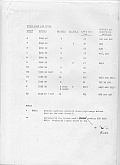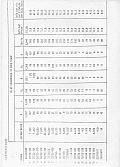To see all of the Report
click for PDF file: 1971PerformanceStudiesPaper.pdf



. This page most recent revision: 31 Jan 2011
Abstract:
This paper summarises various figures from up to 20 performance
studies during 1969-1971 using the AMAP tool.
Most of the studies were of different live customer installations
covering 360 models 40, 50 and 65, almost all running under
MFT.
The system performance levels are presented to show how a sample
of typical users are actually utilizing the CPU and disks. The
difference between actual use and system capability should be
noted. It emphasises the potential, and the need, to educate
and to increase customer satisfaction with IBM.
OS System Dataset referencing accounts for much of the disk
accessing. Actual figures live situations are again given to
illustrate this and to indicate the need good Resident Option
lists.
Summaries of the loading of Access Method modules, transient
SVC call-lib members show that the supplied 'standard lists'
are in many circumstances far from ideal. The figures will help
the reader to select good basic lists for systems without unlimited
core.
Introduction
The intention of this paper is to pass on some of. the experience
gained in various customer performance studies.
During the course of these studies many similarities have been
noticed across the different installations analysed. This paper
should give practical help, and food for thought, to SE's dealing
with the multitude of medium sized OS MFT installations.
There is often a large gap between the potential performance
of a customer system and the actual performance being achieved.
The figures in this report illustrate that this is a very common
situation even in quite mature installations. Hopefully the
practical points and discussions in this paper reduce the gaps
that may exist in many other installations.
The author has drawn on some 20 of his performance studies With
the AMAP tool. The studies have covered about 13 different customer
systems plus a few personal investigation runs of different
subjects. These runs have been under OS Releases 16 to 19 on
Models 40 and 50 (with 1 65), all except one run being under
MFT.
Six of the more recent customer studies are analysed in more
detail in the various Sections of this paper. Obviously all
the installations remain anonymous, but they are from various
industries from insurance to process, although no university
or purely scientific-type job shop has been studied.
Since AMAP was the tool used, the figures result from runs,
lasting up to an hour, of "Representative Jobstreams". As is
well known there is usually no such thing as a truly representative
jobstream.
However even if individual studies are open to some questioning
on this point it is sensible to argue that over all the studies
together some reasonably typical work was run. In fact nearly
all the studies probably ran the AMAP-traces work noticeably
more efficiently (e.g. less blow-ups', idle partitions, mounting
delays, operation decisions etc) than day-to-day work.
Thus actual performance levels are very likely to be lower than
those present here. Therefore there is even more scope for performance
studies to ensure that Proposed systems do do the proposed workload
when installed, and that installed customer satisfaction with
IBM is high.
| .
To see all of the Report |



|
|
Comments, queries and messages to:
ibmmemories@glading.com
Parent page: IBMMemories1970s.htm
This
Page originally 'on the web' Jan 2011
© Doug Glading ..... 2011 |

|